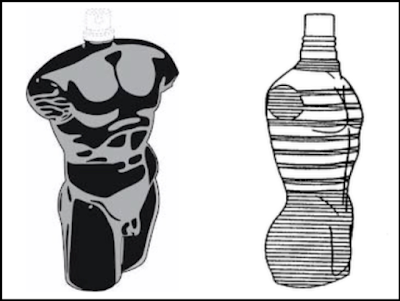The USPTO recently refused registration of the 3D mark filed by Coscentra B.V. shown below left (colour is not claimed as a feature of the mark) for goods ultimately identified as “Perfumery, essential oils, articles for body- and beauty-care, namely, perfumes” in Class 3, based on the existence of a prior registration of the configuration mark shown below on the right hand side (the drawing is lined for the color blue), also for “perfumes” in Class 3. [Case reference: In re Coscentra B.V., Serial No. 79196465 (March 26, 2019) [not precedential] (Opinion by Judge Lorelei Ritchie)].

The USPTO found the two marks confusingly similar. Specifically, the determination was based on an analysis of the probative facts in evidence that were relevant to the factors bearing on a likelihood of confusion (inter alia, the [du Pont] factors). In considering the evidence of record on these factors, the USPTO focused on two fundamental inquiries, i.e. the cumulative effect of differences in the essential characteristics of the goods and differences in the marks:
(A) The goods, trade channels and purchasers
Given that the respective identifications of goods, namely “perfumes”, were identical, thus without restrictions as to nature, type, channels of trade, or classes of purchasers, the identical goods were presumed to travel in the same channels of trade to the same class of purchasers;
(B) The marks
The USPTO deemed that the two marks were similar in appearance, connotation, and overall common commercial impression, noting that the side-by-side approach was inappropriate:
Under actual marketing conditions, consumers do not necessarily have the luxury of making side-by-side comparisons between marks, and must rely upon their imperfect recollections… The focus is on the recollection of the average purchaser, who normally retains a general rather than a specific impression of trademarks.
The applicant argued that, albeit that both marks were indeed in the shape of a “male torso”, they were sufficiently different, particularly in the aspects of physique and the male genitalia part, which enabled the consumers not to be confused about the source of the goods:
1. Consumers are accustomed to seeing the male form in all forms of media and can see that not all men have the same physique;
2. Applicant’s mark comprises more musculature and definition, with a well proportioned torso, while the registrant’s mark shows a slender upper body and a disproportionately larger buttocks;
3. A penis is not commonly shown in consumer products and applicant’s mark comprises a penis, which prospective consumers are likely to notice; and
4. The arms are cut shorter in the registrant’s mark, but cut longer in applicant’s mark, therefore highlighting broader shoulders.
In that regard, the Trademark Trial and Appeal Board (the TTAB) opined that:
- Despite the differences in certain aspects of the marks, the determination must base on the considerations of the appearance, connotation, and commercial impressions of the marks, as a whole — “it is the overall commercial impression of the marks derived from viewing the marks in their entireties that is controlling rather than an analysis of the specific details.”;
- There was no evidence supporting that the cited mark was either commercially nor conceptually weak, rather, it was registered on the Principal Register without any disclaimer or claim of acquired distinctiveness. Plus, the Examining Attorney submitted into the record dozens of images of perfume bottles, only two or three of the images depicted human figures in some form, and none of the third-party images depicted a perfume container in the form of a male torso.
Conclusion
After considering all of the arguments and evidence of record as they pertain to the relevant du Pont factors, the TTAB concluded the likelihood of confusion between the two configuration marks both for perfumes, and affirmed the Section 2(3) refusal to register the applicant’s mark.
Fun for Sunday:
Imagine you are standing in front of a perfume counter and you are forced to need to buy only one of the two torso-shaped perfumes, but (of course) you forget the exact name of the product, so, how would you make the specific description?
[Originally published on The IPKat on 14 April 2019]